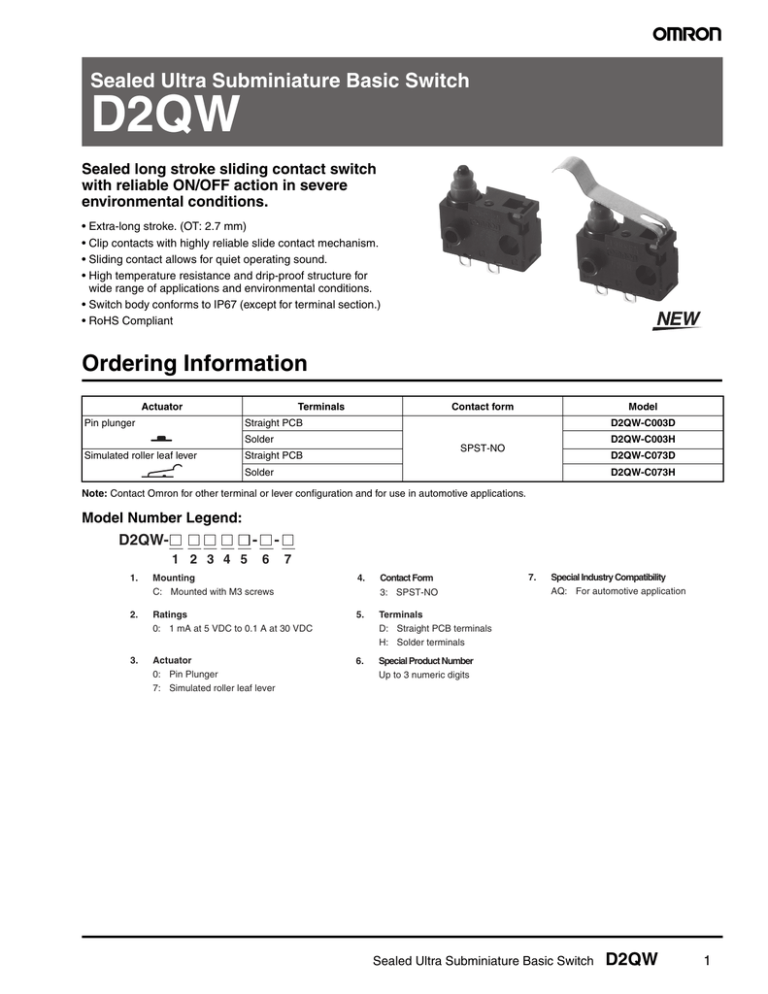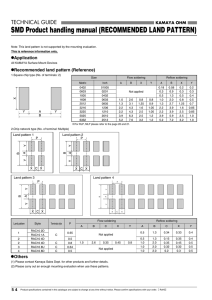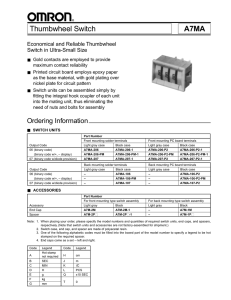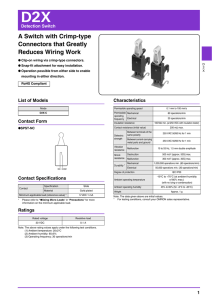Ordering Information
advertisement

Sealed Ultra Subminiature Basic Switch
D2QW
Sealed long stroke sliding contact switch
with reliable ON/OFF action in severe
environmental conditions.
• Extra-long stroke. (OT: 2.7 mm)
• Clip contacts with highly reliable slide contact mechanism.
• Sliding contact allows for quiet operating sound.
• High temperature resistance and drip-proof structure for
wide range of applications and environmental conditions.
• Switch body conforms to IP67 (except for terminal section.)
• RoHS Compliant
Ordering Information
Actuator
Pin plunger
Terminals
Contact form
Model
Straight PCB
D2QW-C003D
Solder
Simulated roller leaf lever
D2QW-C003H
SPST-NO
Straight PCB
D2QW-C073D
Solder
D2QW-C073H
Note: Contact Omron for other terminal or lever configuration and for use in automotive applications.
Model Number Legend:
D2QW-
1 2 3 4 5
6
7
1.
Mounting
C: Mounted with M3 screws
4.
Contact Form
3: SPST-NO
2.
Ratings
0: 1 mA at 5 VDC to 0.1 A at 30 VDC
5.
Terminals
D: Straight PCB terminals
H: Solder terminals
3.
Actuator
0: Pin Plunger
7: Simulated roller leaf lever
6.
Special Product Number
Up to 3 numeric digits
7.
Special Industry Compatibility
AQ: For automotive application
Sealed Ultra Subminiature Basic Switch
D2QW
1
Specifications
■ Characteristics
Item
Permissible Operating speed
Permissible Operating frequency
Insulation resistance
Contact resistance
Dielectric strength
Specification
1 mm to 500 m/s
30 operations/min
100 MΩ min. (at 500 VDC with insulation tester)
100 mΩ max.
600 VAC, 50/60 Hz for 1 min between terminals of the same polarity
1,500 VAC, 50/60 Hz for 1 min between current-carrying metal parts and ground, and
between each terminal and non-current-carrying metal parts
Malfunction: 10 to 55 Hz, 1.5-mm double amplitude
Vibration resistance (See note 2)
Shock resistance (See note 2)
Destruction: 1,000 m/s2 max.
Malfunction: 300 m/s2 max.
Ambient operating temperature
Ambient operating humidity
Degree of protection
Degree of protection against electric shock
Proof tracking index (PTI)
Life expectancy
Mechanical
(30 operations/min)
Electrical
(20 operations/min)
Weight
–40 to 85 °C (with no icing at ambient humidity of 60% max.)
95% max. (for 5 to 35°C)
IEC IP67 (excluding the terminals on terminal models)
Class I
175
500,000 operations min.
200,000 operations min. (at 30 VDC 0.1 A)
500,000operations min. (at 14 VDC 10 mA)
Approx. 0.7 g (for pin plunger models)
Note: 1. Data shown are of initial value.
2. For pin plunger models, the above values apply for use at the free position, operating position, and total travel position. For models with
levers, the values apply at the total travel position.
■ Ratings
Rated voltage (V)
30 VDC
14 VDC
■ Contact Specifications
Resistive load
0.1 A
10 mA
Note: The resistive load ratings apply under the following test conditions:
Ambient Temperature = 20±2°C,
Ambient Humidity = 65±5%,
Operating frequency = 30 operations/min.
2
Sealed Ultra Subminiature Basic Switch
Item
Specification
Material
Minimum applicable load
(reference value)
Specification
Slide
Gold plated
1 mA at 5 VDC
Note: Minimum applicable loads are indicated by N standard reference values. This value represents the failure rate at a 60%
(λ60) reliability level (JIS C5003).
The equation λ60=0.5 x 10-6 / operations indicates that a failure
rate of 1/2,000,000 operations can be expected at a reliability
level of 60%
D2QW
Engineering Data
■ Mounting Structure and Reference Positions for Operating Characteristics
Note: All units are in millimeters unless otherwise indicated.
1.7 dia.
8.3±0.1
(4)
8.2±0.2
5.3±0.2
3 +0.1
0 dia. holes
OT
FP OP
0
3 −0
.1
M3 Tap
(depth 1.5 mm min.)
.
±0.1
3.2
TTP
Contact Form
SPST-NO
Mounting Hole Dimensions (Reference)
dia
5.1
3 +0.1
0
ia.
d
4.2
8.3±0.1
COM
NO
13.3±0.2
■ Terminals
Straight PCB Terminals (D)
Solder Terminals (H)
PCB Mounting Dimensions
(Reference)
3-1+0.1
0 dia. holes
3
0.9
3
1.8
0.4
5.08±0.05
5.08±0.1
4.53
1.2
2
0.4
Dimensions and Operating Characteristics
Note: 1. All units are in millimeters unless otherwise indicated.
2. The illustrations are for solder terminal models. Refer to 'Terminals' for details on models with Straight PCB terminals.
Pin Plunger Models
8.3±0.1
D2QW-C003@
1.7 dia.
8.2±0.2
(4)
5.3±0.2
Characteristic
D2QW-C003@
OF max.
1.5 N {153 gf}
OT ref.
(2.7 mm)
9.2 mm
FP max.
OP
8.4±0.3 mm
TTP max.
5.9 mm
OT
FP
.
OP
TTP
0
±0.1
3
.
.1
3−0
dia
3.2
5.1
+0.1
0
dia
4.2
3
1.8
4.53
2-1.2
2-2
0.4
13.3±0.2
Simulated Roller Leaf Lever Models
D2QW-C073@
8.2±0.2
5.3±0.2
3.4
t=0.2 Stainless-steel lever
OT
(0.55)
FP
OP
(1.7)
ia.
TTP
±
3.2
0
3 −0
.1
5.1
3 +0.1
0
dia.
4.2
3
1.8
2-1.2
2-2
d
0.1
Characteristic
D2QW-C073@
OF max.
1.5 N {153 gf}
OT ref.
(3.5 mm)
14.4 mm
FP max.
OP
12.0±0.5 mm
TTP max.
8.7 mm
4.53
0.4
13.3±0.2
Sealed Ultra Subminiature Basic Switch
D2QW
3
Precautions
Be sure to read the precautions and information common to all Snap Action and Detection Switches, contained in the Technical User’s Guide,
“Snap Action Switches, Technical Information” for correct use.
■ Cautions
■ Correct Use
Degree of Protection
Mounting
JIS C0920, degree of protection: 7, Model: Waterproof.
IEC Publication 529, degree of protection IP67.
Turn OFF the power supply before mounting or removing the Switch,
wiring, or performing maintenance or inspection. Failure to do so may
result in electric shock or burning.
Do not use this product in water. Although molded lead wire models
satisfy the test conditions for the standard given above, this test is to
check the ingress of water into the switch enclosure after submerging
the Switch in water for a given time. Satisfying this test condition
does not mean that the Switch can be used in water.
Do not operate the Switch when it is exposed to water spray, or when
water drops adhere to the Switch surface, or during sudden temperature changes, otherwise water may intrude into the interior of the
Switch due to a suction effect.
Prevent the Switch from coming into contact with oil and chemicals.
Otherwise, damage to or deterioration of Switch materials may
result.
Do not use the Switch in areas where it is exposed to silicon
adhesives, oil, or grease, otherwise faulty contact may result due to
the generation of silicon oxide.
Soldering
When soldering the lead wire to the terminal, first insert the lead wire
conductor through the terminal hole and then conduct soldering.
Complete soldering within 3 s using a soldering iron with a capacity
of 50 W max. and a tip temperature of 300 °C max.
Also, do not apply an external force to the Switch for 1 minute after
the completion of soldering.
Improper soldering involving an excessively high temperature or
excessive soldering time may deteriorate the characteristics of the
Switch.
For M3-screw mounting models, use M3 mounting screws with plane
washers or spring washers to securely mount the Switch. Tighten the
screws to a torque of 0.27 to 0.29 N·m {28 to 30 gf}. Exceeding the
specified torque may result in deterioration of the sealing or damage.
Secure the posts by thermal caulking or by pressing into an attached
device. When pressed into an attached device, provide guides on the
opposite ends of the posts to ensure that they do not fall out or rattle.
Mount the Switch onto a flat surface. Mounting on an uneven surface
may cause deformation of the Switch, resulting in faulty operation or
damage.
Operating Body
Use an operating body with low frictional resistance and of a shape
that will not interfere with the sealing rubber, otherwise the plunger
may be damaged or the sealing may deteriorate.
Handling
Do not handle the Switch in a way that may cause damage to the
sealing rubber.
When handling the Switch, ensure that pressure is not applied to the
posts in the directions shown in the following diagram. Also, ensure
that uneven pressure or pressure in a direction other than the operating direction is not applied to the Actuator as shown in the following
diagram. Otherwise, the post, Actuator, or Switch may be damaged,
or the service life may be reduced.
When using automatic soldering, solder at at 260 °C max and complete soldering with 5 seconds. Pay careful attention so that flux or
solder liquid does not flow over the edge of the PCB panel.
Side-actuated (Cam/Dog) Operation
When using a cam or dog to operate the Switch, factors such as the
operating speed, operating frequency, push-button indentation, and
material and shape of the cam or dog will affect the durability of the
Switch. Confirm performance specifications under actual operation
conditions before using the Switch in applications.
Using Micro Loads
Even when using micro load models within the operating range,
inrush currents or surges may decrease the life expectancy of the
Switch. Therefore, insert a contact protection circuit where necessary.
4
Sealed Ultra Subminiature Basic Switch
D2QW
MEMO
Sealed Ultra Subminiature Basic Switch
D2QW
5
All sales are subject to Omron Electronic Components LLC standard terms and conditions of sale, which
can be found at http://www.components.omron.com/components/web/webfiles.nsf/sales_terms.html
ALL DIMENSIONS SHOWN ARE IN MILLIMETERS.
To convert millimeters into inches, multiply by 0.03937. To convert grams into ounces, multiply by 0.03527.
OMRON ON-LINE
OMRON ELECTRONIC
COMPONENTS LLC
Global - http://www.omron.com
USA - http://www.components.omron.com
55 E. Commerce Drive, Suite B
Schaumburg, IL 60173
847-882-2288
Cat. No. B117-E-03
6
11/13
Specifications subject to change without notice
Sealed Ultra Subminiature Basic Switch
D2QW
Printed in USA



